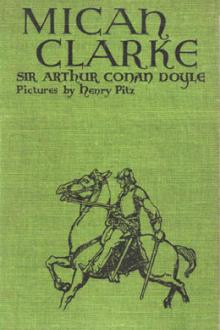Three Thousand Years of Mental Healing, George Barton Cutten [crime books to read TXT] 📗

- Author: George Barton Cutten
- Performer: -
Book online «Three Thousand Years of Mental Healing, George Barton Cutten [crime books to read TXT] 📗». Author George Barton Cutten
Following Paracelsus, Glocenius, Burgrave, Helinotius, Robert Fludd, and Kircher believed that the magnet represented the universal principle by which all natural phenomena might be explained. This principle, existing as it did in the human body, was an important factor in health and disease. The great chemist Von Helmont (1577-1644) taught more precisely that a power resided in man by which he could magnetically affect others, and thereby cure the sick who were most influenced by it. He published a work on the effects of magnetism on the human frame.
About the same time Balthazar Gracian, a Spaniard, boldly proclaimed his views. "The magnet," he said, "attracts iron; iron is found everywhere; everything, therefore, is under the influence of magnetism.... It is the same agent which gives rise to sympathy, antipathy, and the passions." Baptista Porta (1543-1615), one of the originators of the weapon-salve, had also great faith in the magnet. So effective was his work on the imaginations of his patients that he was considered a magician and prohibited from practising by the court of Rome. Sebastian Wirdig, professor of medicine at the University of Rostock, in Mecklenburg, wrote a treatise on "The New Medicine of the Spirits" which he presented to the Royal Society of London in 1673. He maintained that a magnetic influence took place, not only between the celestial and terrestrial bodies, but between all living things. The whole world was under the influence of magnetism: life was preserved by magnetism, death was the consequence of magnetism.
Maxwell (1581-1640) propagated somewhat the same doctrine. He was a firm believer in sympathetic cures, and assumed a vital spirit of the universe which related all bodies. It was probably from this that Mesmer got his idea of what he called the universal fluid. It would seem, however, that Maxwell was aware of the great influence of imagination and suggestion. He said: "If you wish to work prodigies, abstract from the materiality of beings—increase the sum of spirituality in bodies—rouse the spirit from its slumbers. Unless you do one or other of these things—unless you can bind the idea, you can never perform anything good or great." About the same time, in Italy, Santanelli propagated the theory of a universal fluid. Everything material possessed a radiating atmosphere which operated magnetically. He also recognized, however, the great influence of the imagination.
F. A. MESMER
About the year 1771, Father Hell, a Jesuit, and professor of astronomy at the University of Vienna, became famous through his magnetic cures, and invented steel plates of a peculiar form which he applied to the naked body as a cure for several diseases. In 1774 he communicated his system to Mesmer, the man who, more than any one else, drew the world's attention to the investigation of mental healing. Various estimates have been made of Mesmer's character and he frequently has been condemned. He was fond of display, but it is doubtful if he was more avaricious than most persons who lived before and have lived since. He was evidently honest in his scientific investigations and opinions, and this is our main concern.
Friederich Antony Mesmer (1733-1815) was born at Mersbury, in Swabia, and studied medicine at the University of Vienna. He read freely the books written by the authors already mentioned, and accepted much of their teaching. His originality consisted principally in applying to the sick this universal principle, by means of contact and passes, while his predecessors infused the vital spirit through the use of talismans and of magic boxes. He took his medical degree in 1766 and chose as the subject of his inaugural dissertation "The Influence of the Planets in the Cure of Diseases." In this dissertation he maintained "that the sun, moon, and fixed stars mutually affect each other in their orbits; that they cause and direct in our earth a flux and reflux not only in the sea, but in the atmosphere, and affect in a similar manner all organized bodies through the medium of a subtle and mobile fluid, which pervades the universe, and associates all things together in mutual intercourse and harmony." This influence, he said, was particularly exercised on the nervous system, and produced two states, which he called intension and remission, which seemed to him to account for the different periodical revolutions observable in several maladies.
Eight years later he met Father Hell, and after trying some experiments with his metallic plates was astonished at his success. He continued working with Hell for some time, but they finally quarrelled, and shortly afterward he stumbled upon his theory of animal magnetism. After this he no longer used the magnet in healing. The Academy of Science at Berlin examined his claims, but their report was far from favorable or flattering. Nevertheless, writing to a friend from Vienna, he said: "I have observed that the magnetic is almost the same as the electric fluid, and that it may be propagated in the same manner, by means of intermediate bodies. Steel is not the only substance adapted to this purpose. I have rendered paper, bread, wool, silk, stones, leather, glass, wood, men, and dogs—in short, every thing I touched—magnetic to such a degree, that these substances produced the same effects as the loadstone on diseased persons. I have charged jars with magnetic matter in the same way as is done with electricity." About this time he was nominated a member of the Academy of Bavaria.
Leaving Vienna and travelling through Swabia and Switzerland, he met Gassner and witnessed some of his cures. Mesmer claimed that they were performed by his newly discovered magnetism. He arrived in Paris in 1778 and found this city more receptive to his arts. He at first established himself in an humble quarter of the city and began to expound his theory. The following year he published a paper in which he summed up his claims in twenty-seven assertions to which he rigidly held through his life. His doctrines were well received, and acquired an impetus at the beginning by the conversion of one of the leading physicians of the faculty of medicine, Deslon, the Comte d'Artois' first physician.
Pupils and patients now flocked to him. The crowd was so great that Mesmer employed a valet toucheur to magnetize in his place. This was not sufficient; he then invented the famous baquet, or trough, around which thirty persons might simultaneously be magnetized. This baquet is described as follows: "A circular, oaken case, about a foot high, was placed in the middle of a large hall, hung with thick curtains, through which only a soft and subdued light was allowed to penetrate; this was the baquet. At the bottom of the case, on a layer of powdered glass and iron filings, there lay full bottles, symmetrically arranged, so that the necks of all converged toward the centre; other bottles were arranged in the opposite direction, with their necks toward the circumference. All these objects were immersed in water, but this condition was not absolutely necessary, and the baquet might be dry. The lid was pierced with a certain number of holes, whence there issued jointed and moving iron branches, which were to be held by the patients. Absolute silence was maintained. The patients were ranged in several rows round the baquet, connected with each other by cords passed round their bodies, and by a second chain, formed by joining hands."187
Additional features were provided to heighten the effect of the magnetic charm. "Richly stained glass shed a dim religious light on his spacious saloons, which were almost covered with mirrors. Orange blossoms scented all the air of his corridors; incense of the most expensive kinds burned in antique vases on his chimney-pieces; æolian harps sighed melodious music from distant chambers; while sometimes a sweet female voice, from above or below, stole softly upon the mysterious silence that was kept in the house and insisted upon from all visitors."188
Bailly, the historian and celebrated astronomer, an eye-witness, describes the results. "Some patients remain calm and experience nothing; others cough, spit, feel slight pain, a local or general heat, and fall into sweats; others are agitated and tormented by convulsions. These convulsions are remarkable for their number, duration, and force, and have been known to persist for more than three hours. They are characterized by involuntary, jerking movements in all the limbs, and in the whole body, by contraction of the throat, by twitchings in the hypochondriac and epigastric regions, by dimness and rolling of the eyes, by piercing cries, tears, hiccough, and immoderate laughter. They are preceded or followed by a state of languor or dreaminess, by a species of depression, and even by stupor.
"The slightest sudden noise causes the patient to start, and it has been observed that he is affected by a change of time or tune in the airs performed on the pianoforte; that his agitation is increased by a more lively movement, and that his convulsions then become more violent. Patients are seen to be absorbed in the search for one another, rushing together, smiling, talking affectionately, and endeavoring to modify their crises. They are all so submissive to the magnetizer that even when they appear to be in a stupor, his voice, a glance, or a sign will rouse them from it. It is impossible not to admit, from all these results, that some great force acts upon and masters the patients, and that this force appears to reside in the magnetizer. This convulsive state is termed the crisis. It has been observed that many women and few men are subject to such crises; that they are only established after the lapse of two or three hours, and that when one is established, others soon and successively begin.
"When the agitation exceeds certain limits, the patients are transported into a padded room; the women's corsets are unlaced, and they may then strike their heads against the padded walls without doing themselves any injury." Notwithstanding these means, thousands were healed of their diseases.
"It is impossible," says Baron Dupotet, "to conceive the sensation which Mesmer's experiments created in Paris. No theological controversy, in the earlier ages of the Catholic Church, was ever conducted with greater bitterness." He was called a quack, a fool, and a demon, while his friends were as extravagant in his praise as his foes in their censure. After this great excitement, his life may largely be summed up in his challenges to different societies, the appointment of commissions, their examinations, and their reports.
On the advice of Deslon he challenged the Faculty of Medicine, proposing to select twenty-four patients, of whom twelve should be treated according to the old and approved methods and twelve magnetically, the cures to prove the efficacy of the treatment. The faculty declined to accept the conditions. Deslon asked his colleagues on the faculty to summon a general meeting to examine the matter. Through





Comments (0)